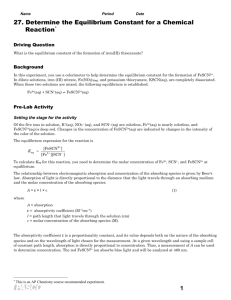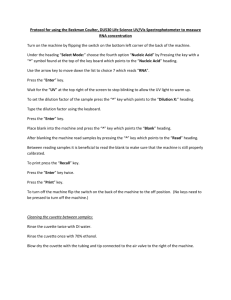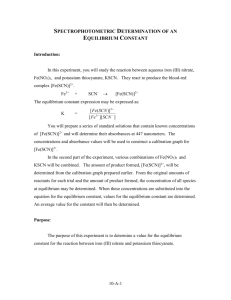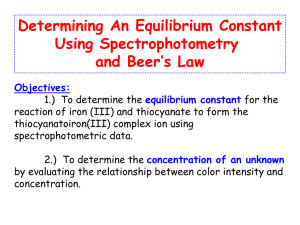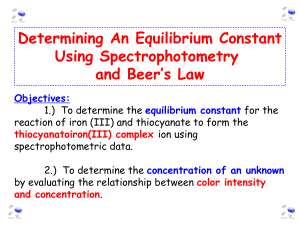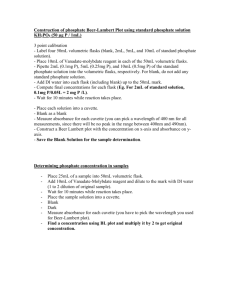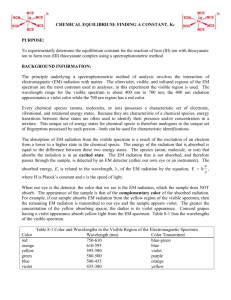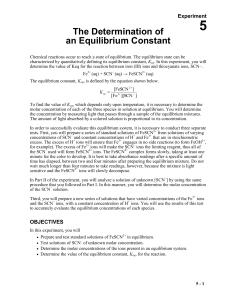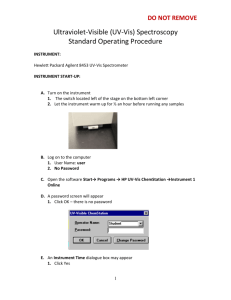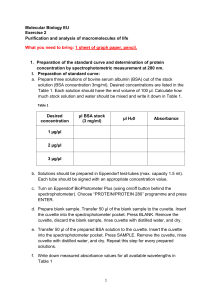DETERMINATION OF AN EQUILIBRIUM
advertisement
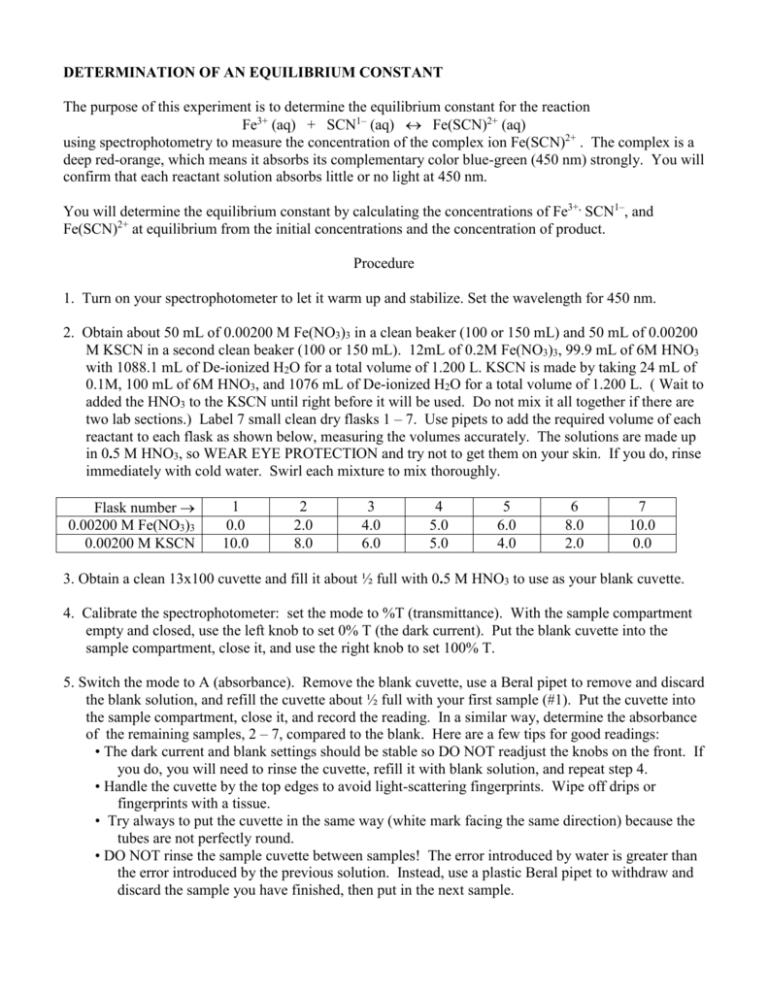
DETERMINATION OF AN EQUILIBRIUM CONSTANT The purpose of this experiment is to determine the equilibrium constant for the reaction Fe3+ (aq) + SCN1– (aq) Fe(SCN)2+ (aq) using spectrophotometry to measure the concentration of the complex ion Fe(SCN)2+ . The complex is a deep red-orange, which means it absorbs its complementary color blue-green (450 nm) strongly. You will confirm that each reactant solution absorbs little or no light at 450 nm. You will determine the equilibrium constant by calculating the concentrations of Fe3+, SCN1–, and Fe(SCN)2+ at equilibrium from the initial concentrations and the concentration of product. Procedure 1. Turn on your spectrophotometer to let it warm up and stabilize. Set the wavelength for 450 nm. 2. Obtain about 50 mL of 0.00200 M Fe(NO3)3 in a clean beaker (100 or 150 mL) and 50 mL of 0.00200 M KSCN in a second clean beaker (100 or 150 mL). 12mL of 0.2M Fe(NO3)3, 99.9 mL of 6M HNO3 with 1088.1 mL of De-ionized H2O for a total volume of 1.200 L. KSCN is made by taking 24 mL of 0.1M, 100 mL of 6M HNO3, and 1076 mL of De-ionized H2O for a total volume of 1.200 L. ( Wait to added the HNO3 to the KSCN until right before it will be used. Do not mix it all together if there are two lab sections.) Label 7 small clean dry flasks 1 – 7. Use pipets to add the required volume of each reactant to each flask as shown below, measuring the volumes accurately. The solutions are made up in 0.5 M HNO3, so WEAR EYE PROTECTION and try not to get them on your skin. If you do, rinse immediately with cold water. Swirl each mixture to mix thoroughly. Flask number 0.00200 M Fe(NO3)3 0.00200 M KSCN 1 0.0 10.0 2 2.0 8.0 3 4.0 6.0 4 5.0 5.0 5 6.0 4.0 6 8.0 2.0 7 10.0 0.0 3. Obtain a clean 13x100 cuvette and fill it about ½ full with 0.5 M HNO3 to use as your blank cuvette. 4. Calibrate the spectrophotometer: set the mode to %T (transmittance). With the sample compartment empty and closed, use the left knob to set 0% T (the dark current). Put the blank cuvette into the sample compartment, close it, and use the right knob to set 100% T. 5. Switch the mode to A (absorbance). Remove the blank cuvette, use a Beral pipet to remove and discard the blank solution, and refill the cuvette about ½ full with your first sample (#1). Put the cuvette into the sample compartment, close it, and record the reading. In a similar way, determine the absorbance of the remaining samples, 2 – 7, compared to the blank. Here are a few tips for good readings: • The dark current and blank settings should be stable so DO NOT readjust the knobs on the front. If you do, you will need to rinse the cuvette, refill it with blank solution, and repeat step 4. • Handle the cuvette by the top edges to avoid light-scattering fingerprints. Wipe off drips or fingerprints with a tissue. • Try always to put the cuvette in the same way (white mark facing the same direction) because the tubes are not perfectly round. • DO NOT rinse the sample cuvette between samples! The error introduced by water is greater than the error introduced by the previous solution. Instead, use a plastic Beral pipet to withdraw and discard the sample you have finished, then put in the next sample. 6. Discard the mixtures down the drain and rinse everything thoroughly (deionized water, of course). Analysis and Discussion 1. Calculate the value of Kc for each mixture separately, then average the values that are consistent. For each analysis, first write the chemical equation. Beneath it, construct an “ICE” table: initial concentration, change in concentration, equilibrium concentration: Fe3+ (aq) + SCN1– (aq) Fe(SCN)2+ initial I change C equilibrium E Fill in the initial working concentrations from the composition of the mixture you are analyzing. Don't forget to account for dilution; for example, the initial concentration of Fe3+ in flask #2 is 2.0 mL Fe(NO3 )3 1 Fe3 0.00200M Fe(NO3 )3 4.0 10 4 M 10.0 mL mixture 1 Fe(NO3 )3 The initial concentration of Fe(SCN)2+ is zero for all flasks. 2. Calculate the equilibrium concentration of Fe(SCN)2+ produced using Beer’s Law: A = abc A = absorbance, a unitless quantity because it is the log of a ratio a = absorptivity constant, which depends on the substance and on b = path length or cuvette diameter c = solution concentration, in moles per liter –1 Using 6120 M for the constant product ab in your experiment, calculate [Fe(SCN)2+] at equilibrium for each mixture from its absorbance. The Fe(SCN)2+ formed at the expense of the reactants, so they each changed by losing that much. Calculate the final concentration of each component, and calculate the value of Kc: Fe(SCN )2 Kc Fe3 SCN 1 3. Average the consistent Kc values and report the result. If the reagents are fresh, expect a value of around 100 for Kc. Discuss the reliability of this result and the sources of error in the experiment.

